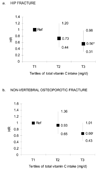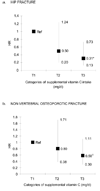Protective effect of total and supplemental vitamin C intake on the risk of hip fracture--a 17-year follow-up from the Framingham Osteoporosis Study
- PMID: 19347239
- PMCID: PMC2766028
- DOI: 10.1007/s00198-009-0897-y
Protective effect of total and supplemental vitamin C intake on the risk of hip fracture--a 17-year follow-up from the Framingham Osteoporosis Study
Abstract
Vitamin C may play a role in bone health. In the Framingham Study, subjects with higher total or supplemental vitamin C intake had fewer hip fractures and non-vertebral fractures as compared to subjects with lower intakes. Therefore, vitamin C may have a protective effect on bone health in older adults.
Introduction: Dietary antioxidants such as vitamin C may play a role in bone health. We evaluated associations of vitamin C intake (total, dietary, and supplemental) with incident hip fracture and non-vertebral osteoporotic fracture, over a 15- to 17-year follow-up, in the Framingham Osteoporosis Study.
Methods: Three hundred and sixty-six men and 592 women (mean age 75 +/- 5 years) completed a food frequency questionnaire (FFQ) in 1988-1989 and were followed for non-vertebral fracture until 2003 and hip fracture until 2005. Tertiles of vitamin C intake were created from estimates obtained using the Willett FFQ, after adjusting for total energy (residual method). Hazard ratios were estimated using Cox-proportional hazards regression, adjusting for covariates.
Results: Over follow-up 100 hip fractures occurred. Subjects in the highest tertile of total vitamin C intake had significantly fewer hip fractures (P trend = 0.04) and non-vertebral fractures (P trend = 0.05) compared to subjects in the lowest tertile of intake. Subjects in the highest category of supplemental vitamin C intake had significantly fewer hip fractures (P trend = 0.02) and non-vertebral fractures (P trend = 0.07) compared to non-supplement users. Dietary vitamin C intake was not associated with fracture risk (all P > 0.22).
Conclusion: These results suggest a possible protective effect of vitamin C on bone health in older adults.
Figures



Similar articles
-
Protective effect of total carotenoid and lycopene intake on the risk of hip fracture: a 17-year follow-up from the Framingham Osteoporosis Study.J Bone Miner Res. 2009 Jun;24(6):1086-94. doi: 10.1359/jbmr.090102. J Bone Miner Res. 2009. PMID: 19138129 Free PMC article.
-
Cross-sectional and prospective associations between dietary and plasma vitamin C, heel bone ultrasound, and fracture risk in men and women in the European Prospective Investigation into Cancer in Norfolk cohort.Am J Clin Nutr. 2015 Dec;102(6):1416-24. doi: 10.3945/ajcn.115.111971. Epub 2015 Nov 4. Am J Clin Nutr. 2015. PMID: 26537939
-
Dietary magnesium and potassium intakes and circulating magnesium are associated with heel bone ultrasound attenuation and osteoporotic fracture risk in the EPIC-Norfolk cohort study.Am J Clin Nutr. 2015 Aug;102(2):376-84. doi: 10.3945/ajcn.114.102723. Epub 2015 Jul 1. Am J Clin Nutr. 2015. PMID: 26135346
-
Vitamin C intake in relation to bone mineral density and risk of hip fracture and osteoporosis: a systematic review and meta-analysis of observational studies.Br J Nutr. 2018 Apr;119(8):847-858. doi: 10.1017/S0007114518000430. Br J Nutr. 2018. PMID: 29644950
-
Effects of Milk and Dairy Products on the Prevention of Osteoporosis and Osteoporotic Fractures in Europeans and Non-Hispanic Whites from North America: A Systematic Review and Updated Meta-Analysis.Adv Nutr. 2019 May 1;10(suppl_2):S120-S143. doi: 10.1093/advances/nmy097. Adv Nutr. 2019. PMID: 31089740 Free PMC article.
Cited by
-
Antioxidant and Bone; Protect Your Future: A Brief Review.Iran J Public Health. 2021 Sep;50(9):1783-1788. doi: 10.18502/ijph.v50i9.7049. Iran J Public Health. 2021. PMID: 34722373 Free PMC article. Review.
-
Sufficient Plasma Vitamin C Is Related to Greater Bone Mineral Density among Postmenopausal Women from the Boston Puerto Rican Health Study.J Nutr. 2021 Dec 3;151(12):3764-3772. doi: 10.1093/jn/nxab291. J Nutr. 2021. PMID: 34510185 Free PMC article.
-
Role of vitamins beyond vitamin D3 in bone health and osteoporosis (Review).Int J Mol Med. 2024 Jan;53(1):9. doi: 10.3892/ijmm.2023.5333. Epub 2023 Dec 8. Int J Mol Med. 2024. PMID: 38063255 Free PMC article. Review.
-
Skeletal effects of nutrients and nutraceuticals, beyond calcium and vitamin D.Osteoporos Int. 2013 Mar;24(3):771-86. doi: 10.1007/s00198-012-2214-4. Epub 2012 Nov 14. Osteoporos Int. 2013. PMID: 23152094 Review.
-
Associations of different dietary patterns, bone mineral density, and fracture risk among elderly women: the China Osteoporosis Prevalence Study.Front Endocrinol (Lausanne). 2024 Jun 12;15:1378158. doi: 10.3389/fendo.2024.1378158. eCollection 2024. Front Endocrinol (Lausanne). 2024. PMID: 38933818 Free PMC article.
References
-
- Riggs BL, Melton LJ., 3rd The worldwide problem of osteoporosis: insights afforded by epidemiology. Bone. 1995;17:505S–511S. - PubMed
-
- Ray NF, Chan JK, Thamer M, Melton LJ., 3rd Medical expenditures for the treatment of osteoporotic fractures in the United States in 1995: report from the National Osteoporosis Foundation. J Bone Miner Res. 1997;12:24–35. - PubMed
-
- Cummings SR, Melton LJ. Epidemiology and outcomes of osteoporotic fractures. Lancet. 2002;359:1761–1767. - PubMed
-
- Prevention and management of osteoporosis. World Health Organ Tech Rep Ser 921. 2003:1–164. back cover. - PubMed
-
- Macdonald HM, New SA, Golden MH, Campbell MK, Reid DM. Nutritional associations with bone loss during the menopausal transition: evidence of a beneficial effect of calcium, alcohol, and fruit and vegetable nutrients and of a detrimental effect of fatty acids. Am J Clin Nutr. 2004;79:155–165. - PubMed
Publication types
MeSH terms
Substances
Grants and funding
LinkOut - more resources
Full Text Sources
Other Literature Sources
Medical

